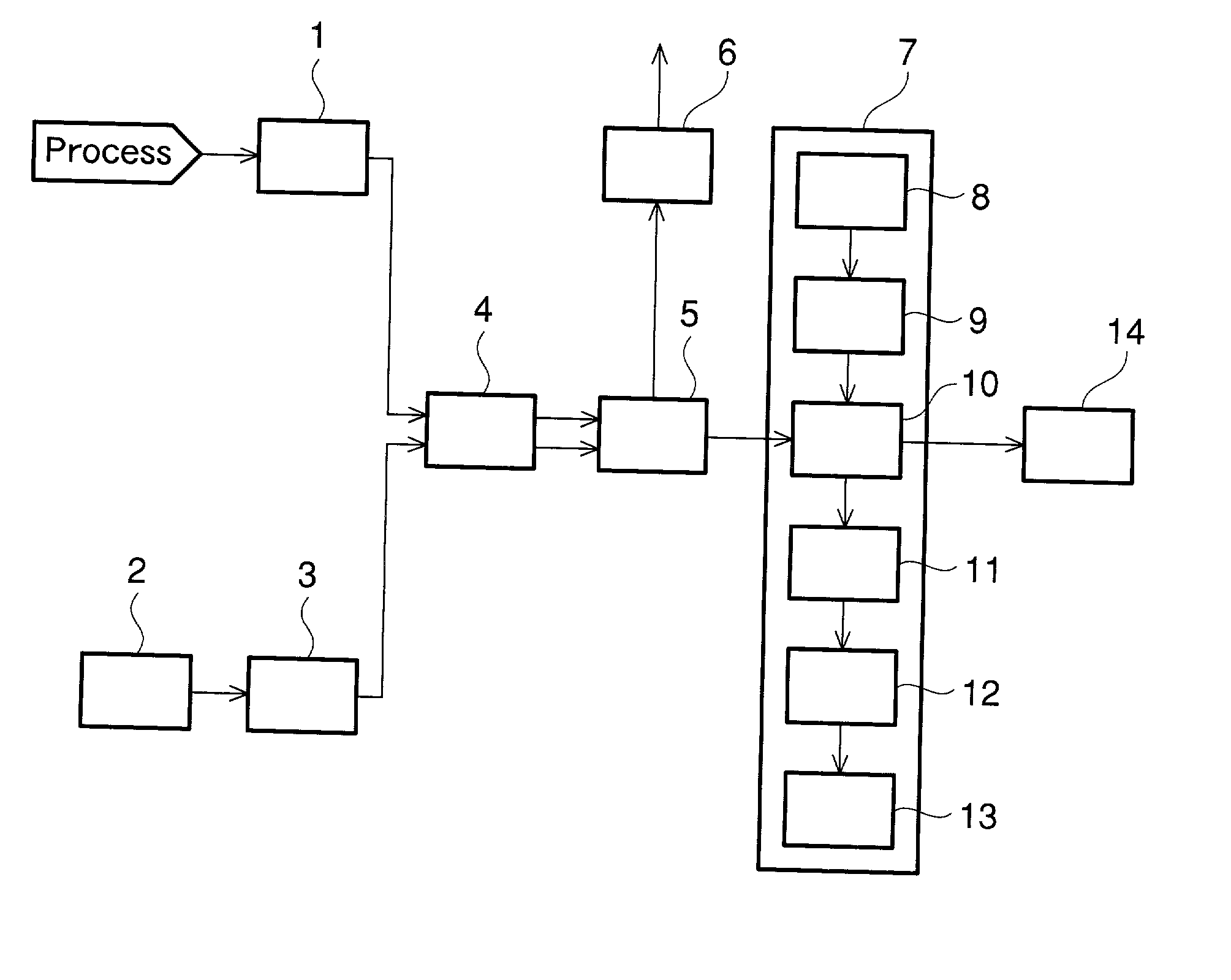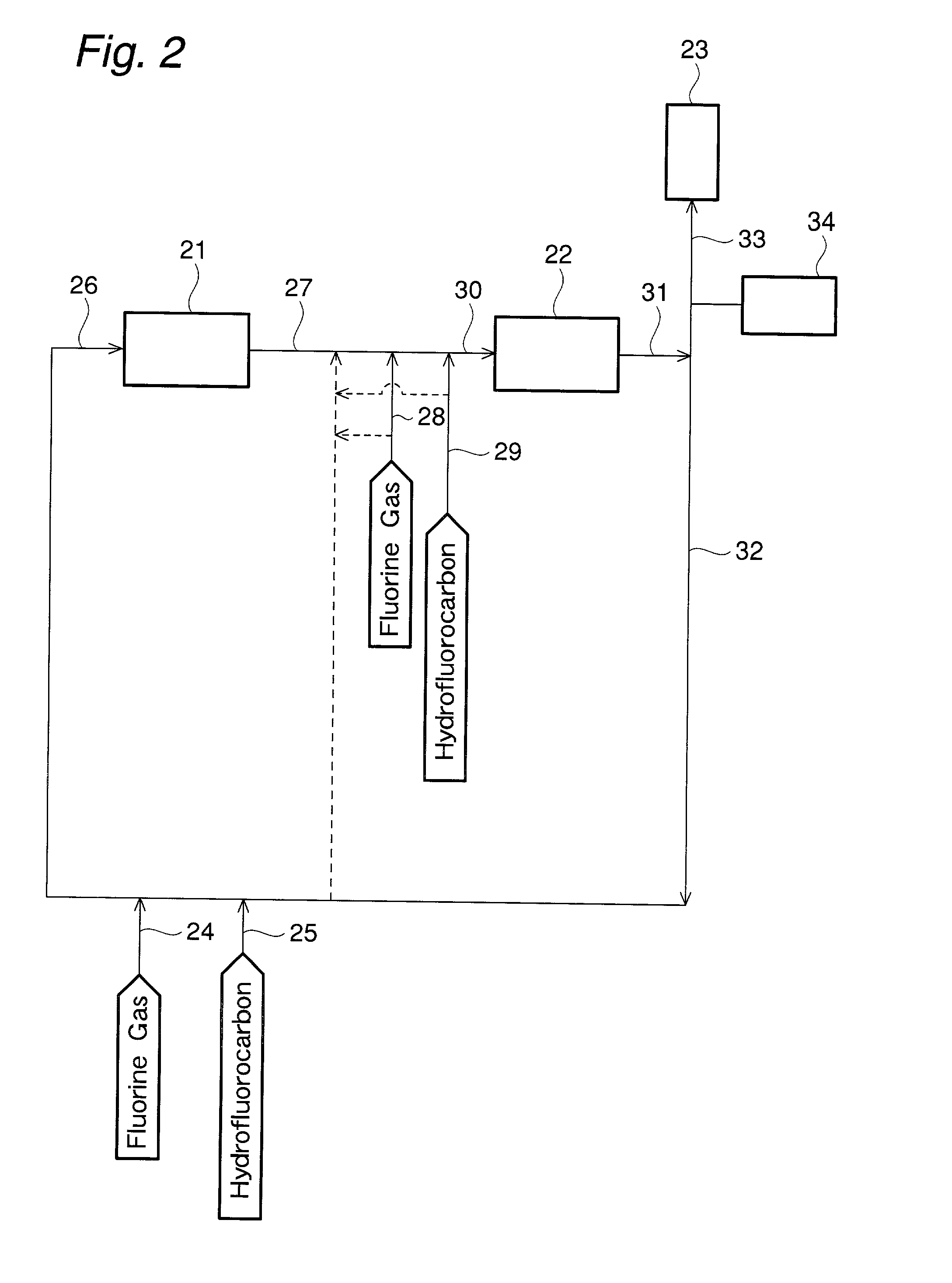Measuring method for concentration of halogen and fluorine compound, measuring equipment thereof and manufacturing method of halogen compound
a technology of halogen and fluorine compound and measuring equipment, which is applied in the direction of mechanical means, instruments, specific gravity measurements, etc., can solve the problems of inconvenient use, large excess of halogen gas, and delay in measuring results, so as to achieve safe and quick determination
- Summary
- Abstract
- Description
- Claims
- Application Information
AI Technical Summary
Benefits of technology
Problems solved by technology
Method used
Image
Examples
example 1
[0181] Trifluoromethane (HFC-23) was directly fluorinated in the presence of a diluent gas in a continuous process to produce tetrafluoromethane (FC-14). The fluorine gas concentration in the process gas under four different conditions was measured with the apparatus shown in FIG. 1. In the measurement, the potassium iodide-starch solution and the process gas were allowed to flow through the reaction section at flow rates of 2 mL / min and 20 mL / min respectively in the same manner as mentioned above. The fluorine gas concentration was derived from the output of the optical sensor, and was also confirmed simultaneously by titration with sodium thiosulfate. The concentration measured by the sodium thiosulfate titration, and the output levels of the optical sensor are shown Table 2 and FIG. 3. The output levels of the optical sensor are on the same line as the standard values shown in FIG. 3, which shows the high reliability of the results of the measurement of remaining fluorine gas con...
example 2
[0182] The process in FIG. 2 for producing perfluorocarbon is explained. Trifluoromethane as the hydrofluorocarbon (25 in FIG. 2) and fluorine gas (24 in FIG. 2) were mixed with a diluent gas (32 in FIG. 2), and the gas mixture (26 in FIG. 2) was introduced into a first reaction zone (21 in FIG. 2). In the first reaction zone, the reaction was allowed to proceed under the conditions of the reaction pressure of 1.5 MPa, the reaction temperature of 400.degree. C., the molar ratio of F.sub.2 / trifluoromethan-e of 1.51, and the trifluoromethane concentration at the inlet of 2.1 mole % to obtain an outlet gas (27 in FIG. 2) of the first reaction zone.
[0183] To this outlet gas, 1,1,1,2-tetrafluoroethane as a new hydrofluorocarbon (29 in FIG. 2), and fluorine gas (28 in FIG. 2) were added. The gas mixture (30 in FIG. 2) was introduced to a second reaction zone (22 in FIG. 2). In the second reaction zone, the reaction was allowed to proceed under the conditions of the reaction pressure of 1....
example 3
[0184] A reactor employed had an inner diameter of 20.6 mm. a length of 500 mm, being made of inconel 600, being of an electric heater type, and having been passivated by fluorine gas at 600.degree. C. The reactor was heated to 280.degree. C. with passage of a diluent gas (composed of 41.8 vol % of tetrafluoromethane as a perfluorocarbon, and 58.2 vol % hydrogen fluoride) at a flow rate of 50 NL / h. To one portion of the separated diluent gas flow, 1,1,1,2-tetrafluoroethane was introduced as a hydrofluorocarbon at a flow rate of 1.0 NL / h. Similarly, to the other portion of the separated diluent gas flow, fluorine gas was introduced at a flow rate of 2.0 NL / h to cause direct fluorination. A part of the reactor inlet gas was introduced into a heated measurement cell (window material: calcium fluoride) by an automatic switching valve made of SUS316 driven pneumatically, and was subjected to infrared spectrum measurement by an infrared spectrophotometer.
[0185] Table 4 shows the infrared ...
PUM
 Login to View More
Login to View More Abstract
Description
Claims
Application Information
 Login to View More
Login to View More - R&D
- Intellectual Property
- Life Sciences
- Materials
- Tech Scout
- Unparalleled Data Quality
- Higher Quality Content
- 60% Fewer Hallucinations
Browse by: Latest US Patents, China's latest patents, Technical Efficacy Thesaurus, Application Domain, Technology Topic, Popular Technical Reports.
© 2025 PatSnap. All rights reserved.Legal|Privacy policy|Modern Slavery Act Transparency Statement|Sitemap|About US| Contact US: help@patsnap.com



